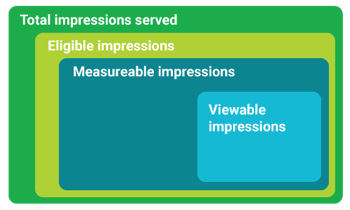Imagine that you are driving by a 14-foot tall billboard that’s facing the wrong way of the road. As a marketer, you think: “Who in their right mind would throw money away on ads that people will never see?”.
Though it’s pretty easy to notice if something is off with real-life billboards, things can get a little complicated with digital ads.
Ad viewability is to the internet what standard billboard requirements are to outdoor advertising—you have to make sure that everything has been set up right for results to show.
Whether you are a PPC newbie or you’d simply like to learn more on this topic, here are all the whys and wherefores of ad viewability:
- What is Ad Viewability?
- Why Is Ad Viewability Important?
- Ad Impressions – What Are Viewable Impressions?
- What is Active View?
- How to Improve Ad Viewability
- Ad Viewability on Social Media
- Ad Viewability Rates Across Different Industries
- The Future of Ad Viewability
What is Ad Viewability?
Ad viewability is a term used to describe how visible an ad is to users. Display web and mobile ads count as viewable when 50% of the creative set is in view for at least 1 second. Video ads become viewable when 50% of them are in view and playing for at least two consecutive seconds.
The first viewability definition concerning digital ads was issued by the Interactive Advertising Bureau (IAB) and the Media Rating Council (MRC) in 2010, as a standing order for performance and cost-effectiveness.
Check out Google’s viewability demo to see how long it takes for an ad to become viewable in real-time.
Why Is Ad Viewability Important?
Back in 2014, Google broke the news to digital advertisers that 56.1% of the total amount of rendered ads never reach users. As shocking as this was, raising awareness on viewability seems to have benefited both publishers and advertisers in the long run. Five years later numbers have significantly improved to an average of 65%, yet there’s room for better.
With so much money invested in digital advertising, stakeholders can rely on viewability to make informed decisions. Plus, publishers get to make the most out of selling their ad space, offering buyers a more transparent view of their options.
Ad Impressions – What Are Viewable Impressions?
Each time an advertisement renders on a web or mobile screen, it automatically becomes an impression. There are four main types of impressions: served, eligible, measurable, and viewable—now let’s make some sense of them:
a. Served Impressions
Ads that are accessed, transmitted, and counted with the use of server data are defined as served impressions. Besides standard impression tracking, server data does not support extensive data analysis on user behavior and the potential interaction with ad-blocking tools, bots, and other technical interferences.
b. Eligible and Measurable Impressions
Ad units that are downloaded and stored on users’ devices count as eligible impressions. All the eligible impressions that meet the technical requirements to be recorded via Active View are labeled as measurable impressions.
c. Viewable Impressions
Viewable impressions are the most relevant viewability component. This metric is used by advertisers to quantify the percentage of the ads that are viewed by real people. Ads that have been displayed on a screen for more than one second, with at least 50% of the pixels showing, classify as viewable impressions. All the viewable impressions are recorded via Active View.
What is Active View?
Active View is an integrated Google tool that shows you how viewability is measured. This handy, MRC-approved tool is the core of viewability reporting and measurement.
While Active View has a user-friendly interface, operating with viewability metrics may require some additional research, so follow this link to get accustomed to the key terms and concepts.
Active View and Conversions
Viewable impressions allow you to try new PPC strategies and raise conversion rates seamlessly. By bidding on viewable CPMs, you can pay for the exact value and placement of your ad.
Read more about this here.
Google Display & Video 360 also provides solutions to increase viewable conversion rates. The advanced ad-buying platform enables advertisers to set custom campaign metrics such as on-screen ad percentage, time threshold, and audibility requirements.
Learn how to enable custom viewability metrics here.
How to Improve Ad Viewability
Ads are designed to pursue and engage users with desired actions, and high conversion rates can only start with ads that users can see. Recent research conducted by Google concluded that viewable display ads have four times more chances to lift conversions than display ads.
Here are the key elements you need to pay attention to when creating and placing ads:
1. Ad Position and Page Length
The position of an ad is strongly correlated with its viewability. Ads can be placed either above or below the fold, but websites don’t have a physical fold like newspapers. The fold begins where the user needs to start scrolling.
As expected, above-the-fold ads are more viewable (+28% for videos and +22% for display ads) than ads placed below the fold. This is also the reason why the above-the-fold ad space costs more. However, this doesn’t mean that below-the-fold ads are not an option worth considering. Based on your bidding strategy and budget, you can always perform some A/B testing and see what works best for you.
Page length also plays an important role in the viewability mix, and shorter, one-fold pages have higher viewability rates. On the other hand, longer pages that feature quality content can also facilitate the efficiency of below-the-fold ads.
2. Ad Size and Layout
Google looked at the commonly used video and display ad sizes and found out that the bigger the ad size and ratio, the better the viewability:
1. 95% of video ads of 2560 x 1440 px are likely to become viewable
2. display ads of 375 x 50 px have a viewability rate of 94%.
See Google’s ranking on viewability rates across common sizes below:
3. Page Load Speed
The pages that take too long to load are the pages that users leave first, so an excellent page loading time is key to great user experience. Hosting Tribunal points out that a 1-second delay reduces page views by 11% and decreases coveted conversion rates and customer satisfaction by 7% and 16%, respectively.
Recent studies by Google also showed that mobile sites with a loading time of 5 seconds or less have a 25% higher viewability rate than sites loading in 19 seconds.
To find out how long it takes for your page to load and how to improve it, run it by Google’s PageSpeed Insights.
There are many technical adjustments you can make to ensure a high load speed on your page. To name a few, you can enable file compression, reduce redirects and optimize images to improve their server response time.
Check out these handy tips & tricks on page speed optimization by Moz.
4. Responsive Ads
A rookie mistake to avoid in 2019 is designing non-responsive ads. With so many screen resolutions and browsers, you can never be sure that you’ve covered all of them. By designing online ads that are responsive you ensure a good user experience and don’t have to worry about optimizing your ads for mobile devices.
Responsive ads will also help you save time, so you won’t have to create different ad groups and campaigns. You can also design responsive ads that yield dynamic remarketing tactics and allow you to add a feed to your campaigns for both static and dynamic ads.
More on creating responsive display ads here.
Ad Viewability on Social Media
Social media users engage with content in various ways—needless to say, ads have to meet different viewability standards. For the most part, ad inventory airs on social platforms as organic content. This is also why most of them support more advanced bidding and targeting options.
Most big social media players go the extra mile to ensure accuracy in viewability reporting and partner up with third-party viewability verification partners. Among the most popular platforms used are Moat, Nielsen, comScore, and IAS.
As a general rule of thumb, social media ads become viewable when displayed for two continuous seconds or more, with at least 50% of pixels in view.
YouTube Leads the Viewability Way
Social media platforms adjust their viewability standards very often for making the ad-space buying process even more appealing to advertisers. Viewable ads on YouTube, for example, have to be on display for 30 seconds or more—no wonder YouTube’s viewability rate is as high as 95%.
Video ads on Facebook and Instagram are viewable when any number of pixels are on display for three uninterrupted seconds. Twitter, on the other hand, has different standards, requiring 100% of the ad’s pixels to be spread out for at least three seconds.
Ad Viewability Rates Across Different Industries
Google looked at viewability rates across various industries and discovered that ads within the Gaming industry hold the highest viewability rates, scoring an average of 82% for video and 80% for display ads. Business & Industrial, Internet & Telecom and Shopping are also content categories worth mentioning, with 72% viewable video ads in all three industries.
The Future of Ad Viewability
Times are changing, and so are viewability standards. In late March 2019, MRC released a draft on the adjustment of video viewability terms. By 2021, video ads will count as viewable only if 100% of their creative sets will be on display for two consecutive seconds:
“For combined deduplicated cross-media video measurement, a viewability qualification threshold of 100% of the pixels on screen for at least two continuous seconds must be utilized for both digital and linear components. Viewable impressions are the minimum required qualifying measurement unit for crossmedia advertising Reach, Frequency and GRP.”
Independent Ad Viewability Tools Are the Next Big Thing
In recent years, unaffiliated ad viewability tools have witnessed a major increase in popularity for all the right reasons. Trust issues are more likely to arise when payees also handle reporting. As fighting fraud in a 333.25-billion-dollar industry is no easy task, experts foresee a bright future for those genuinely conferring advanced viewability tracking solutions.
With technology steadily reshaping the face of advertising, viewability still remains an open topic, and both advertisers and publishers will have to continuously adjust to the fast pace of technological progress.
Read more on this topic:

